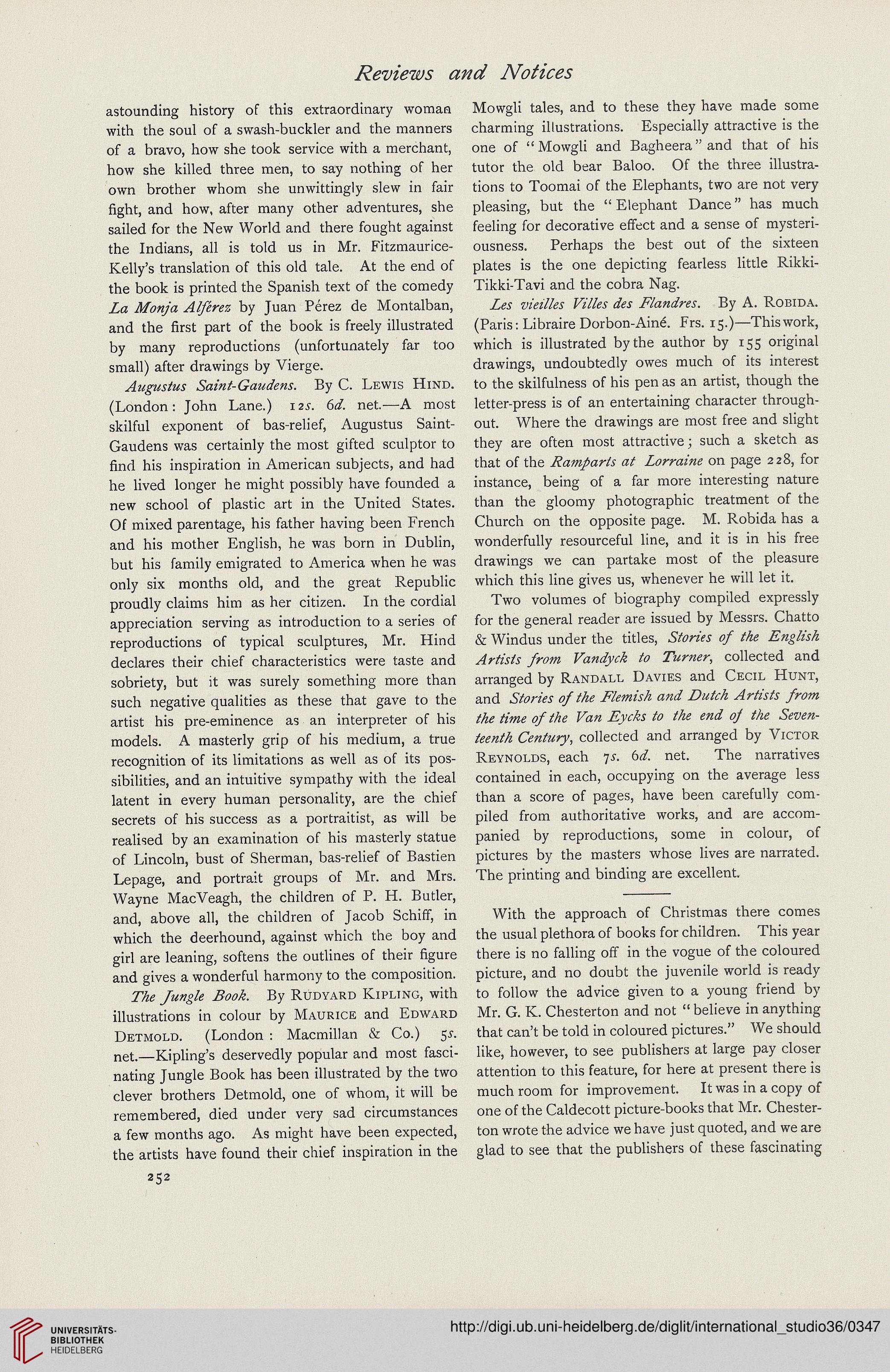astounding history of this extraordinary woman
with the soui of a swash-buckier and the manners
of a bravo, how she took service with a merchant,
how she kiiled three men, to say nothing of her
own brother whom she unwittingly slew in fair
fight, and how. after many other adventures, she
sailed for the New World and there fought against
the Indians, all is told us in Mr. Fitzmaurice-
Kelly's translation of this old tale. At the end of
the book is printed the Spanish text of the comedy
dfoTy'a by Juan Perez de Montalban,
and the first part of the book is freely illustrated
by many reproductions (unfortunately far too
small) after drawings by Vierge.
By C. LEWIS HlND.
(London: John Lane.) i2y. 6<f. net.—A most
skilful exponent of bas-relief, Augustus Saint-
Gaudens was certainly the most gifted sculptor to
hnd his inspiration in American subjects, and had
he lived longer he might possibly have founded a
new school of plastic art in the United States.
Of mixed parentage, his father having been French
and his mother English, he was born in Dublin,
but his family emigrated to America when he was
only six months old, and the great Republic
proudly claims him as her citizen. In the cordial
appreciation serving as introduction to a series of
reproductions of typical sculptures, Mr. Hind
declares their chief characteristics were taste and
sobriety, but it was surely something more than
such negative qualities as these that gave to the
artist his pre-eminence as an interpreter of his
models. A masterly grip of his medium, a true
recognition of its limitations as well as of its pos-
sibilities, and an intuitive sympathy with the ideal
latent in every human personality, are the chief
secrets of his success as a portraitist, as will be
realised by an examination of his masterly statue
of Lincoln, bust of Sherman, bas-relief of Bastien
Lepage, and portrait groups of Mr. and Mrs.
Wayne MacVeagh, the children of P. H. Butler,
and, above all, the children of Jacob SchiF, in
which the deerhound, against which the boy and
girl are leaning, softens the outlines of their ftgure
and gives a wonderful harmony to the composition.
ZHe yiwg'A j?<wA By RuDYARD KiPLixc, with
illustrations in colour by MAURICE and EDWARD
DETMOLD. (London : Macmillan & Co.) gy.
net.—Kipling's deservedly popular and most fasci-
nating Jungle Book has been iHustrated by the two
clever brothers Detmold, one of whom, it will be
remembered, died under very sad circumstances
a few months ago. As might have been expected,
the artists have found their chief inspiration in the
252
Mowgli tales, and to these they have made some
charming illustrations. Especially attractive is the
one of "Mowgli and Bagheera"and that of his
tutor the old bear Baloo. Of the three illustra-
tions to Toomai of the Elephants, two are not very
pleasing, but the "Elephant Dance" has much
feeling for decorative effect and a sense of mysteri-
ousness. Perhaps the best out of the sixteen
plates is the one depicting fearless little Rikki-
Tikki-Tavi and the cobra Nag.
ZM WM7/<M PzV/M <%?J By A. ROBIDA.
(Paris: Libraire Dorbon-Aine. Frs. rg.)—Thiswork,
which is illustrated bythe author by 155 original
drawings, undoubtedly owes much of its interest
to the skilfulness of his pen as an artist, though the
letter-press is of an entertaining character through-
out. Where the drawings are most free and slight
they are often most attractive; such a sketch as
that of the 2?<Z772^C7-A Z<77-7-<M'72<? on page 228, for
instance, being of a far more interesting nature
than the gloomy photographic treatment of the
Church on the opposite page. M. Robida has a
wonderfully resourceful line, and it is in his free
drawings we can partake most of the pleasure
which this line gives us, whenever he will let it.
Two volumes of biography compiled expressly
for the general reader are issued by Messrs. Chatto
& Windus under the titles, .%77-2'M <7/ /<%<:
7-/AL y7*<7773 <*<7 21<7-72C7-, collected and
arranged by RANDALL DAViES and CECiL HuNT,
and -SYwK'.f <y ZXfTTM'.lZ <<7Z</ Z/«/<rZ 7-ZiZ y7-<7777
/7777C <7/ /Ag Fh77 Zy<rZj /<7 /<%<? C77</ <7/ &W77-
/c<?72//% Cc72/M7y, collected and arranged by VicTOR
REYNOLDS, each 7L 6</. net. The narratives
contained in each, occupying on the average less
than a score of pages, have been carefully com-
piled from authoritative works, and are accom-
panied by reproductions, some in colour, of
pictures by the masters whose lives are narrated.
The printing and binding are excellent.
With the approach of Christmas there comes
the usual plethora of books for children. This year
there is no falling off in the vogue of the coloured
picture, and no doubt the juvenile world is ready
to follow the advice given to a young friend by
Mr. G. K. Chesterton and not " believe in anything
that can't be told in coloured pictures." We should
like, however, to see publishers at large pay closer
attention to this feature, for here at present there is
much room for improvement. It was in a copy of
one of the Caldecott picture-books that Mr. Chester-
ton wrote the advice we have just quoted, and we are
glad to see that the publishers of these fascinating





